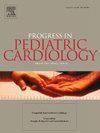新生儿持续性肺动脉高压
IF 0.8
Q4 PEDIATRICS
引用次数: 0
摘要
背景:新生儿持续肺动脉高压与心肺衰竭、神经发育迟缓和死亡的风险增加有关。本文就新生儿围生期肺血管适应正常与异常及持续性肺动脉高压的病因、病理生理、临床表现、诊断方法及治疗进行综述。新生儿持续性肺动脉高压的特点是新生儿出生后肺血管不能适应,导致肺血管阻力持续高,肺外缺氧血右向左分流异常,低氧血症难愈。新生儿持续性肺动脉高压的病因和病理生理可分为四大类,包括结构正常的心肺系统的不适应、肺发育不全、肺实质疾病未发生时肺血管发育不良以及红细胞增多症引起的与血液粘度增加相关的血管内阻塞。新生儿持续性肺动脉高压患儿可出现不稳定低氧血症,伴或不伴呼吸窘迫。评估可包括同时进行导管前后血氧饱和度测量、胸片、超声心动图和动脉血气分析。当超声心动图不可用时,高氧试验可能是有用的。治疗新生儿持续性肺动脉高压的主要目的是逆转肺血管收缩,优化心功能,改善全身氧输送。治疗可包括支持性措施,如镇静、纠正代谢紊乱、处理红细胞增多症、氧疗和机械通气。根据疾病的潜在原因,靶向治疗可包括表面活性剂治疗、肺血管扩张剂治疗和血流动力学状态优化。难治性PPHN患儿可能需要体外膜氧合。中度至重度疾病的幸存者应监测神经异常、听力损失和认知延迟。本文章由计算机程序翻译,如有差异,请以英文原文为准。

Persistent pulmonary hypertension of the newborn
Background
Persistent pulmonary hypertension in the newborn is associated with increased risk of cardiorespiratory failure, neurodevelopmental delay, and death.
Aim of review
The purpose of this article is to review normal and abnormal perinatal pulmonary vasculature adaptation and persistent pulmonary hypertension of the newborn, including etiology, pathophysiology, clinical manifestations, diagnostic methods, and treatment.
Key scientific concepts of review
Persistent pulmonary hypertension of the newborn is characterized by failure of the pulmonary vasculature in the newborn to adapt after birth, resulting in sustained high pulmonary vascular resistance, abnormal extrapulmonary right-to-left shunting of deoxygenated blood, and refractory hypoxemia. The etiology and pathophysiology of persistent pulmonary hypertension of the newborn may be classified into four broad categories, including maladaptation of a structurally normal cardiopulmonary system, underdevelopment of the lungs, maldevelopment of pulmonary vasculature in the absence of pulmonary parenchymal disease, and intravascular obstructions associated with increased blood viscosity from polycythemia. Infants with persistent pulmonary hypertension of the newborn may present with labile hypoxemia, with or without respiratory distress. Evaluation may include simultaneous pre- and post-ductal oxygen saturation measurements, chest radiography, echocardiography, and arterial blood gas analysis. The hyperoxia test may be useful when echocardiography is unavailable. The main goal in treating persistent pulmonary hypertension of the newborn is to reverse pulmonary vasoconstriction, optimize cardiac function, and improve systemic oxygen delivery. Treatment may include supportive measures such as sedation, correction of metabolic disturbances, management of polycythemia, oxygen therapy, and mechanical ventilation. Targeted therapy, depending on the underlying cause of disease, may include surfactant therapy, pulmonary vasodilator therapy, and optimization of hemodynamic status. Infants with refractory PPHN may require extracorporeal membrane oxygenation. Survivors of moderate to severe disease should be monitored for neurologic abnormalities, hearing loss, and cognitive delay.
求助全文
通过发布文献求助,成功后即可免费获取论文全文。
去求助
来源期刊

PROGRESS IN PEDIATRIC CARDIOLOGY
PEDIATRICS-
CiteScore
0.90
自引率
11.10%
发文量
69
审稿时长
75 days
期刊介绍:
Progress in Pediatric Cardiology is an international journal of review presenting information and experienced opinion of importance in the understanding and management of cardiovascular diseases in children. Each issue is prepared by one or more Guest Editors and reviews a single subject, allowing for comprehensive presentations of complex, multifaceted or rapidly changing topics of clinical and investigative interest.
 求助内容:
求助内容: 应助结果提醒方式:
应助结果提醒方式:


